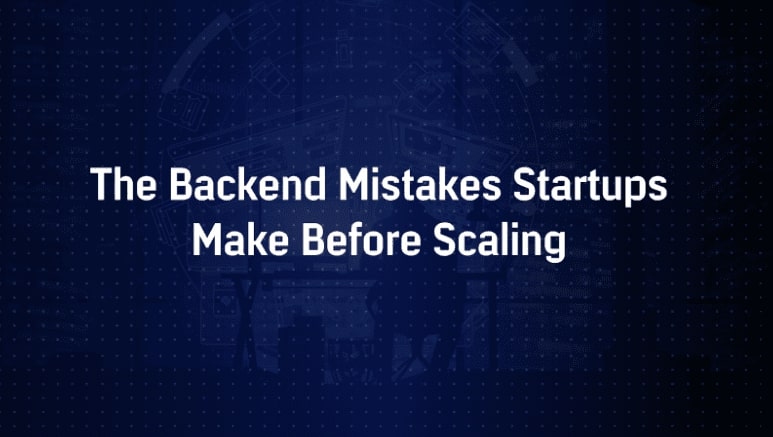Why Startups Fail Before They Scale
Scaling a startup is not just about attracting customers or securing funding. Growth cannot survive on front-end strategies and marketing hacks alone. At the core of every startup is its backend, which often receives less attention in the early stages. The backend is where choices around tech stacks, databases, and API design can determine whether a startup can scale or collapse under pressure. Many ventures overlook these technical foundations in the excitement of launching quickly, yet the damage shows when the company begins to grow.
Recurring backend problems are the primary reason why some startups fail before they scale. Shrinking backend systems devour resources, team morale, time, and finances that should have been spent on rewrites, downtimes, and addressing performance bottlenecks. This is the reason backend robustness separates thriving startups from the stalled ones.
At Empyreal Infotech, years of experience in startup tech solutions have shown how critical backend planning is. Each decision made at the early stage leaves a lasting mark on scalability. The good news is that most backend mistakes are preventable with foresight and the right strategy. Here are the most common ones and how to avoid them.
Mistake #1 – Choosing the Wrong Tech Stack
The foundation of any startup rests on its choice of tech stacks. A stack determines not only the performance of your product but also its future adaptability. Many early-stage companies rush this choice without considering long-term consequences.
Common mistakes include:
-
- Using outdated frameworks for the sake of speed
-
- Selecting stacks based on team familiarity rather than project needs
-
- Ignoring whether the stack supports cloud-native growth or forces an on-premises setup
A classic example is a startup that selected a convenient framework to launch quickly but later discovered it was too rigid to handle scaling. They faced massive re-engineering costs that could have been avoided with the right initial decision. This is why a flexible and modern startup tech stack is vital. The right choice balances speed of development with long-term scalability.
Why a Flexible Tech Stack Matters for Startups
A startup cannot anticipate every challenge, but it can prepare for adaptability. Flexible tech stacks allow integration of new tools, support microservices, and align with modern infrastructure needs. They give the startup freedom to pivot without massive code overhauls.
Short-Term Speed vs Long-Term Scalability
Speed is seductive for a new business eager to release its product. A poorly chosen stack may deliver that speed at the cost of scalability. Once the user base grows, the cracks appear, and the product slows down or becomes unstable. A balanced stack ensures that early efficiency does not compromise future growth.
Mistake #2 – Poor API Design and Integration Planning
In today’s ecosystem, API design is central to startup tech. APIs are the lifeline that connect systems, power integrations, and enable scale. A poorly designed API becomes the silent bottleneck that slows growth.
Mistakes startups often make include:
-
- Building monolithic APIs instead of modular microservices
-
- Neglecting proper documentation, leaving future developers in confusion
-
- Ignoring authentication, encryption, and other basic security standards
The result is a fragile system that breaks as soon as traffic increases or new integrations are added. One startup learned this when its monolithic API could not handle parallel requests from partners, forcing a costly redesign at the moment when they were poised to expand.
Pro Tip:
Think of APIs as the nervous system of your startup. Sloppy design creates chronic issues later, while modular, secure, and well-documented APIs ensure smooth scaling.
Mistake #3 – Ignoring Database Scalability
Databases are the engines of digital products. Yet many startups overlook database planning during the initial build. They rely on default setups that appear to work until user numbers grow.
The most Common mistakes by startup rely on a single server with no scaling strategy, failing to optimize indexing and queries for performance and choosing between SQL and NoSQL without considering actual use cases database scalability requires foresight into growth patterns. Horizontal scaling, where capacity expands by adding servers, works better for some startups, while vertical scaling, which involves upgrading one server’s capacity, may suit others. Ignoring these architectural decisions early often results in outages, slow responses, and frustrated users.
A well-structured database strategy protects against such pitfalls and ensures the product runs smoothly even as usage spikes.
Mistake #4 – Neglecting Security from Day One
Startups frequently postpone addressing security, but they risk losing credibility with a single incident. Security should always be embedded within the architecture. Failure results in breaches, compliance infractions, and erosion of trust.
Common oversights include:
-
- Weak authentication and authorization mechanisms
-
- Hardcoding sensitive credentials within code
-
- Skipping encryption for stored and transmitted data
-
- Ignoring compliance frameworks such as GDPR or HIPAA
Security-first approaches are not just about compliance. They form sustainable solutions that protect the startup from costly rework, fines, and reputational damage. A secure backend supports growth without risk of sudden breakdowns.
Mistake #5 – Building Without Sustainable Solutions in Mind
Early hacks may get a product launched, but unsustainable choices compound over time. Startups that focus only on immediate speed fall into traps that slow them later.
Examples of non-sustainable practices include:
-
- Hardcoding values instead of building modular systems
Skipping proper testing and automated CI/CD pipelines
- Hardcoding values instead of building modular systems
-
- Using free or unsupported libraries that break with updates
Sustainability is not just about technical neatness. It is about ensuring the system can handle real-world growth without crumbling. At Empyreal Infotech, the approach is to embed sustainable solutions into every backend decision. This covers aspects like automation testing and modularity, as well as well-supported community frameworks. When startups adopt sustainable design, they do not have to rewrite code repeatedly and are able to concentrate on innovation instead of battling problems.
Mistake #6 – Underestimating Backend DevOps & Infrastructure Needs
The structure, infrastructure, and information technology frameworks the DevOps understudy builds forms the foundation for backend performance. Most startups under-assess the importance of DevOps and infrastructure planning, only to find out that later, their product is not able to scale with the traffic.
Typical mistakes include:
-
- Running manual deployments instead of automated pipelines
-
- Neglecting monitoring and logging systems
-
- Overlooking cloud cost optimization strategies
Startups that do not use DevOps from the start frequently face disorderly scaling. Implementing automated workflows, strategic planning for the cloud, and proactive monitoring can prevent costly reactive measures. When the focus is on DevOps from the start, scaling is much more of a journey. The responsibilities of DevOps extend far beyond server administration.
It serves as a cultural and operational blueprint that integrates developers, testers, and system administrators, enabling a perpetual cycle of enhancement. Each code release is automated and accurately verifiable and rollbacks, should they be needed, are simple. Startups can become more responsive to user needs without destabilizing their systems through closed-off divisions and automated workflows. A vital feature of improved responsiveness is the use of Automated Continuous Integration and Continuous Delivery (CI/CD) pipelines. With automation in place, all additions and updates for products come with automated evaluation and quality verification processes. Automated systems streamline each release and cut down on human errors.
The failure to implement CI/CD leads to live broken features and lost user trust. Monitoring and logging are vital for real-time error detection and system feedback to the teams. Timely notifications of user-perceived performance issues are a key aspect of monitoring. Comprehensive error records enable speedier problem resolution through detailed examination of system logs. The lack of these systems leads to guesswork during failure recovery, resulting in keytime downtime. Additionally, startups that move to the cloud for cost-effective agility often overlook the importance of strict cost management. A strong DevOps strategy focuses on cloud cost optimization, balancing performance with expense. While cloud service performance optimization is critical, preserving cash is important for these startups. DevOps also plays a part in outlining a strong disaster recovery strategy. A startup that overlooks redundancy and backup strategies is one outage away from losing critical data and hard-earned credibility.
Automation moves, such as multi-region backup deployments and failovers, help preserve data and credibility. Investments in cloud infrastructure communicate strong predictive credibility to investors, as well as emphasize discipline in infrastructure planning.
Finally, the mindset of DevOps cultivates resilience and speed. A startup that invests in infrastructure early sends a message of reliability to investors, customers, and partners. It demonstrates foresight and discipline. The companies that thrive during scale are often the ones that made backend resilience a part of their DNA, not an afterthought.
Conclusion: How Startups Can Build a Scalable Backend
Scaling a startup successfully requires more than market traction. Backend readiness is the difference between growth and collapse. Mistakes with tech stacks, weak API design, poor database planning, lack of security, absence of sustainable solutions, and neglected DevOps are the most common reasons startups fail before they truly scale.
The truth is, scaling is never just about adding more servers or patching in quick fixes. It is about creating a foundation that can carry weight, adapt to demand, and evolve without breaking. Startups that prioritize backend-first thinking find themselves prepared for the pressure that comes with success, while those who delay investment often pay the price in downtime, spiralling costs, or frustrated users who never return.
Backend-first thinking means treating infrastructure not as an afterthought but as the invisible engine of your product. For example, think of a SaaS platform that experiences a sudden surge in users after a big partnership announcement. For a startup, that “success moment” can come at a price if there isn’t a scalable backend, and it can turn into dead weight, in the manner of an outage that hinders a startup’s credibility when it’s trying to build it. This hinders the startup precisely when it needs credibility the most. Startups that manage to build automated deployment pipelines, containerized environments, and clever load balancing, on the other hand, can maintain performance and seamlessly handle sudden spikes in traffic.
The integration of careful planning and enduring architecture provides a solution. In the case of a product, every choice made in the initial phases, such as database tables and API design, plays a role in how smoothly a product can evolve. Sustaining growth prevents later chaos from rewrites with a backend that is modular, testable, and scale optimized. Sustainable solutions, on the other hand, keep growth from being stifled by uncontrolled spending and technical bottlenecks. An example of this is proactive cost monitoring, cloud expense tracking, and performance benchmarking.
Along with everything previously mentioned comes another key component, which is security. During the scaling phase, startups become more susceptible to everything and anything, which puts them at greater risk. A backend scaled to accommodate higher loads is also capable of accommodating additional traffic and, therefore, is resilient. Implementing tested and proven security measures such as encryption, secure and authenticated protocols, and role-restricted access class boundaries need to be incorporated, tested and left as part of the product, rather than being bolted on later.
Equally important is the team’s mindset. Founders and developers who understand that backend readiness is strategic, not just technical, are more likely to avoid reactive firefighting. They focus on building systems that enable growth rather than constantly catching up with it. This shift in perspective changes how resources are allocated, how deadlines are set, and how technology is evaluated.
At Empyreal Infotech, the philosophy is simple: scale is not luck, it is preparation. With deep expertise in Building a SaaS Platform engineering, web development, and CRM development, the team helps startups design backends that are resilient, adaptable, and cost-efficient. Every line of code, every architecture diagram, and every DevOps pipeline is created with future growth in mind. The goal is to free startups from the constant worry of “what if it breaks” so they can focus on what matters most: building products that users love.
If your startup is preparing for the next stage, now is the time to strengthen the backend foundation. Waiting until you have thousands of users to fix infrastructure is like building the roof after the house is already occupied. By partnering with specialists, you not only protect your growth but also accelerate it. The right backend ensures that when your business scales, your technology scales with it smoothly, securely, and sustainably.
Startups that succeed long term are not just the ones with the boldest ideas or the fastest user acquisition. They are the ones who invested early in the invisible backbone of their products. Backend readiness is the quiet force that makes exponential growth possible. With expert guidance and planning, you can build a backend that does not just support your vision today but powers it for years to come. Don’t wait until scaling exposes cracks in your system. Talk to Empyreal Infotech today and build a backend that’s ready for growth from day one.




